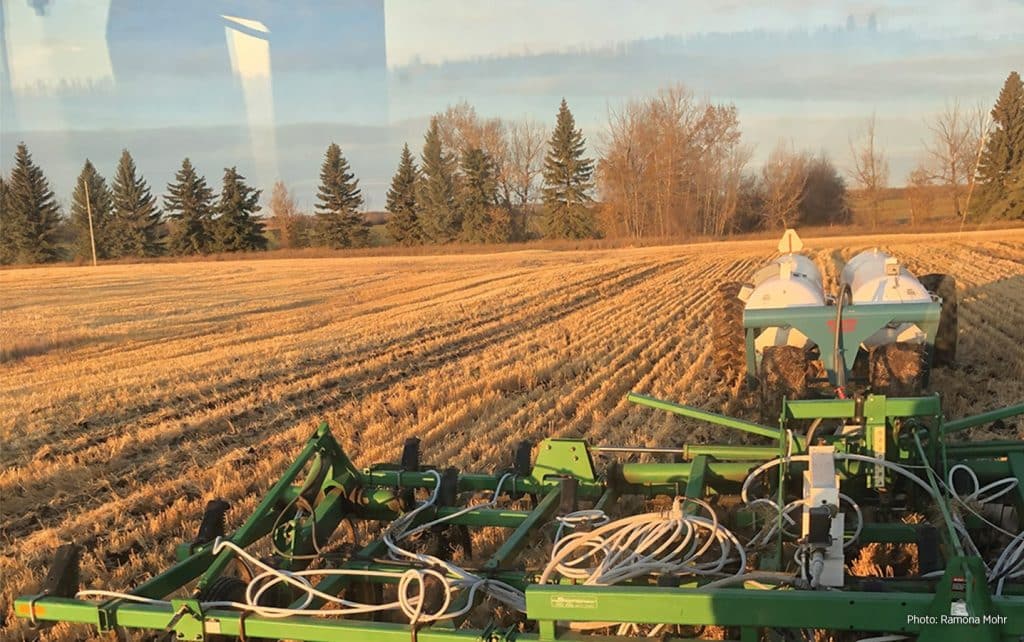Key Result
This one-year study supports previous recommendations that in-soil banding of nitrogen fertilizers during seeding or near to the time of seeding is a best management practice to enhance nitrogen use efficiency (NUE).
Project Summary
Increasing farm size in western Canada has led many farmers to move back to less efficient broadcast nitrogen application in an effort to hasten spring seeding operations. However, surface application of nitrogen (N) fertilizer can increase the potential for volatilization losses, which reduces the nitrogen use efficiency (NUE) of the crop. Selecting appropriate combinations of N fertilizer source and placement method can potentially reduce volatilization losses and improve fertilizer nitrogen use efficiency by canola.
Researchers conducted two field trials in 2017 to identify fertilizer management practices that reduce the potential for volatilization losses, and improve fertilizer nitrogen use efficiency for canola. The objective of the study was to determine the effect of fertilizer source and placement on canola yield, nitrogen and sulphur (S) use efficiency by the canola crop, and nitrogen volatilization losses on calcareous and non-calcareous soils in the Aspen Parkland ecoregion.
In 2017, small-plot field experiments were conducted on calcareous and non-calcareous soils near Brandon, Manitoba. Various treatments were compared, including a control receiving no N or S fertilizer, and a combination of various N and S liquid and granular fertilizers and placement methods, for a total of 18 treatments. Fertilizer sources included ammonium sulphate, ammonium thiosulphate, urea, potassium sulphate, urea ammonium nitrate (with and without Agrotain or ATS), SuperU and/or urea impregnated with ammonium sulphate. Placement methods included pre-plant broadcast, pre-plant band or dribble band after seeding. An N rate of 60 kg/ha, which was expected to be less than that required to achieve optimum yield, was applied to allow differentiation among the N fertilizer treatments.

Banding often reduced early-season volatile N losses compared to surface-applied fertilizer N applications, particularly at the calcareous site. Banding also showed increased N uptake at flowering, suggesting that in-soil banding contributed to a higher available N supply. Pre-plant banding at the calcareous site consistently increased canola yield compared to surface application of granular fertilizer N products, while pre-plant banded urea increased yield compared to surface application of both conventional and enhanced efficiency fertilizers. The per cent fertilizer N recovery was typically higher for banded than broadcast granular fertilizers at the calcareous site.
At the non-calcareous site, the differences among the fertilizer management practices were less frequent. This is likely due to lower soil carbonate concentration and slightly lower soil pH, which may have reduced the potential for volatilization losses. Under the 2017 growing season conditions, the findings showed that surface-application of select fertilizers produced similar canola yields and per cent fertilizer N recoveries as banded treatments. However, researchers caution applying these findings more broadly, given the many growing season and other factors that may influence N volatilization, fertilizer use efficiency and yield response.
Although in some cases in the current study, surface-applied conventional or enhanced efficiency fertilizers performed as well as banded treatments, in no case did surface-applied fertilizer N outperform banded urea in terms of nitrogen use efficiency or crop performance. Decisions regarding surface-application versus in-soil banding of fertilizer N require consideration not only of operational requirements and the direct costs of fertilizer applications, but also of the relative risk of N loss of surface-applied N and the implications with respect to return per fertilizer dollar.
Overall the study findings reflect previous research in western Canada which supports the use of in-soil banding of N fertilizers during seeding or near to the time of seeding as a best management practice to enhance nitrogen use efficiency in canola and other crop production systems.
Work is underway to combine the current findings with previous site-years of data in order to better understand the relative efficiency of various fertilizer management practices under a range of environmental conditions.





